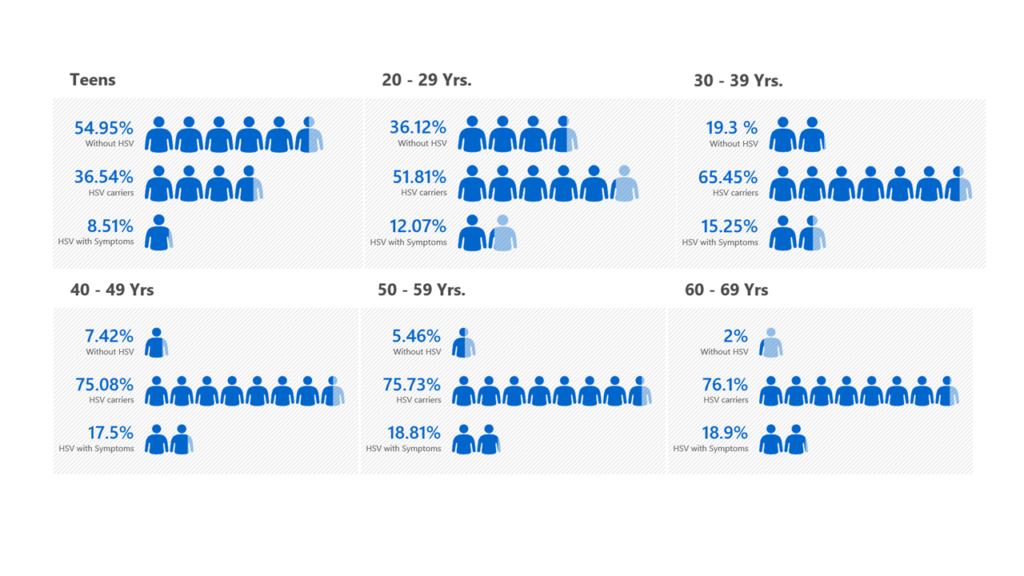Things you never knew about HSV (But wish you did)!
HOW’D SO MANY GET HSV?
“Expecting to live a normal human life without acquiring HSV is about as irrational as expecting to have a normal sex life without losing your virginity. 90% of humanity carries at least one Herpes Simplex Virus. Ultimately, what hurts people most is that they don’t KNOW this.”
CR Fauchald (Founder, ProjectAccept.org)
So, you just found out that you or a partner have Herpes Simplex? Well, you’re certainly not alone; you just don’t know it yet. 90% of people worldwide – and nearly 75% of the US population – currently hosts at least one Herpes Simplex Virus. Surprised? Most people are when they find out. While most adults do carry (and spread) HSV, only 18.9% have noticeable symptoms – Herpes Simplex itself – the sores on the skin – only occurs in around 1/5 of HSV carriers, due to their individual immune systems. This can often be managed through proper diet and avoiding stressors to the body and mind. Over 80% of hosts tolerate HSV fine, with no recognizable symptoms; one reason most people don’t know they carry HSV.

HOW’D SO MANY GET HSV?
This one is easy. As of 2011, there were 9 human herpesviruses. Even chickenpox is caused by a herpesvirus. Nearly everybody gets at least 2-3 different herpes viruses before they even acquire the Herpes Simplex Virus. However, in this infographic we’re specifically counting ONLY the two types of Herpes Simplex Virus: HSV-1 & HSV-2. Many people think there is a big difference between the two; they are SO wrong. Not only did they start out as the very same virus, but either type can still infect ANY surface of the body and both are capable of transmitting via physical contact, even with no outbreak present.
The reason so many carry HSV is simply because: 1) HSV is relatively easy to acquire, and 2) We’re surrounded by opportunities to acquire it, since most people carry it at least one type. In addition, since over 80% of people don’t show symptoms, they’ve no idea they have it, they have no concern for precautions and it’s readily passed on to others. In fact, experts estimate that 70-75% of HSV transmissions occur in an asymptomatic state; from someone without symptoms. Out of sight, out of mind… and that cycle continues.
HOW DO WE STOP IT?
We couldn’t stop HSV any more than we could stop the common cold. There is currently no cure for the virus, regardless of what you might read on the Internet. (Please, ignore all that stuff. It’s all snake oil, ripoffs and some is even poisonous.) Neither can we keep humans from kissing, which is how the vast majority of HSV infections are transmitted. A fair amount, however, is transmitted through oral sex and genital sex, but let’s face it: nobody’s giving those up either and condoms offer rather limited protection. Stopping HSV is out of the question until a vaccine is found. In the meantime, there are many ways to cure the disease itself and to help avoid any future recurrences. Taking care of your health is the first step. Diet, exercise and reducing stressors to your body and mind can make a big difference for most. Avoid too much sun; too much alcohol; lack of sleep/rest; too much physical stress; too much emotional/mental stress. Every bit adds up to stress and your immune system has enough to do as it is, so if you take care of it, it will take care of you. While you will always host HSV, you may well be capable of reducing or eliminating active, clinical herpes episodes (outbreaks) and live a perfectly normal life. Antiviral medications are also available for those who aren’t able to control it on their own.
47.8%
US population which carries HSV-1. Keep in mind that HSV prevalence is VERY age-dependent: hardly any babies have it, but nearly all the elderly have it. More than half of us have HSV-1 by our early 20’s and it keeps going up as we age.
11.9%
HSV-2 prevalence in the US (all ages.) This is down slightly from 15.3% a decade earlier. Again, it is highly age-dependent: by their 50’s, around 1/4 of men and 1/2 of women are carriers.
90.0%
Nearly everyone gets HSV. Worldwide, 90% already carry one type and in the US, 90% have HSV-1 alone by age 80. Add in HSV-2 and you reach 90% decades sooner. In many countries, 90% is achieved even before adulthood.
>50%
As researchers have worked to understand HSV better, they’ve realized that an entire sector of Genital Herpes has been ignored: Genital HSV-1. Studies in locations worldwide have shown that at least half of new Genital Herpes infections are actually HSV-1 rather than HSV-2. This suggests that at least twice as many people have a genital HSV infection as previously believed. While exact numbers are not yet known, the average of all the GHSV-1 studies is well above 50% of new infections.
WHAT CAN WE LEARN FROM THIS?
The main lesson is, having HSV is perfectly normal. You didn’t know that before, so it’s a bit of a shock, but it’s absolutely true. Most adults have it. It’s actually having symptoms which is rather rare… and that’s due to personal immune systems, not the viruses.
≤ 90%
Nearly 90% of those with HSV are asymptomatic; they either have no symptoms or they are so light that they don’t recognize anything is wrong.
20%
Less than 20% have apparent HSV symptoms. Their immune systems aren’t strong enough at present, but there are plenty of ways to improve that.
MOVING FORWARD
It’s normal to go through some pretty strong emotions when you’re first awakened to the reality of HSV. Most people simply have no idea of what’s going on out there in the world. But, now that you know there’s nothing to “go back” to… you can begin to move forward. You and your partner are both perfectly normal, healthy adults and you’re probably both carriers of some type of HSV. One of you may have symptoms; one may not; that depends upon your immune systems. Education and awareness can certainly help. Take some time to adjust and take care of yourself and to learn. When you’re ready to get involved in teaching others that there’s nothing “casual” about casual sex and that safe sex isn’t quite as safe, perhaps, as you’d once believed, visit www.projectaccept.org
Sources: Katharine J Looker,Geoffrey P Garnett & George P Schmid, An estimate of the global prevalence and incidence of herpes simplex virus type 2 infection, Bull World Health Organ 2008 Oct;86(10):805-12 Xu F, Sternberg MR, Kottiri BJ, et al. Trends in Herpes Simplex Virus Type 1 and Type 2 Seroprevalence in the United States. JAMA.2006;296(8):964-973. doi:10.1001/jama.296.8.964 Kimberlin DW. The scarlet H. J Infect Dis. 2014 Feb 1;209(3):315-7. doi: 10.1093/infdis/jit459. Epub 2013 Oct 16 Wald A, Corey L. Persistence in the population: epidemiology, transmission. In: Arvin A, Campadelli-Fiume G, Mocarski E, et al., editors. Human Herpesviruses: Biology, Therapy, and Immunoprophylaxis. Cambridge: Cambridge University Press; 2007. Chapter 36







